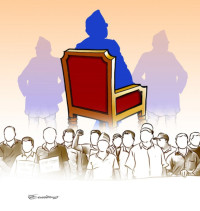Opinion
Traversing transitions
A few international examples on power sharing during transitions can help Nepal map its own path
Yogendra P Paneru
Power sharing in a transition, though challenging, can be instrumental in successfully completing post-peace agreements. Generally, post-conflict nations have a set of unintended but perverse challenges. Serious dangers, however, can be resolved when power-sharing institutions operate under conditions, such as a political ‘culture of accommodation’. Security concerns are likely to be acute following an insurgency because all parties have recent, concrete evidence of the hostile intentions of their adversaries and former rebels would have made too many commitments with their allies.
But it is the very capacity of power-sharing institutions to avoid the hazards of democracy that make it so attractive as a means of initiating a transition from civil war to democratic peace. Former enemies of armed conflicts regularly rely on the promise of consociation as a means to accomplish these goals and manage internal conflicts. One of the reasons behind the unsuccessful attempts of the last Constituent Assembly (CA) to promulgate a new constitution was an accommodation failure in government. We can look at a few international examples on how power sharing during transitions has been conducted.
South Africa
Nineteen South African political groups signed the Convention for a Democratic South Africa (CODESA) Declaration of Intent with the formation of an interim government. The African National Congress (ANC) and two other parties were prime actors. The ANC proposed an interim government, with legislative and executive powers, appointed by CODESA to manage the transition. This deal had two motives: an interim government council that would function until the CA completed its drafting of the constitution and the CA would be vested with sovereign powers to also function as a legislature. The deal had provisioned that any party holding more than five percent seats in Parliament was entitled to receive one or more Cabinet portfolios. A party that received twenty percent of the seats was entitled to receive the position of Deputy President.
Eventually, elections took place in April 1994 using proportional representation and a constitutionally-defined multi-party government of national unity was formed the same year. There were several appointments to the Cabinet from all existing political parties and independents.
Northern Ireland
The Northern Ireland example was not so fascinating during the first phase, similar to Nepal. This included the Good Friday Agreement that came into effect in 1998. Proportional representation was used to ensure that the Unionist (mainly Protestant) and Nationalist (mainly Catholic) communities participated in government in proportion to the seats they won in the legislative assembly. Unfortunately, the main parties failed to reach an advance consociation agreement, fearing power would return to London and that was a situation that none of the parties desired. Afterward, Northern Ireland recognised that without a power-sharing deal, durable peace was not possible.
Its experience of consociation comprised of two phases. The first phase was a post-agreement government (1999-2002), dominated by the Ulster Unionist Party (UUP) and the Social Democratic and Liberal Party (SDLP), two moderate parties. The failure of the Irish Republican Army (IRA) to disarm and other security issues led to tensions and the Assembly and power-sharing executive were suspended after October 2002. Subsequently, the 2006 St Andrews Agreement established a deal that led the peace process. The second consociation attempt was UUP and Sinn Féin, which became the two largest parties following the 2007 elections. Even in the second phase, relationships between the parties were not comfortable but accommodation became unavoidable to complete the peace process.
Cambodia
After 1991, a power-sharing pact was established through a Supreme National Council (SNC) in coordination with the United Nations. The SNC was headed by ousted Prince Sihanouk and included representatives from three major parties, the Khmer People’s National Liberation Front (KPNLF), the royalist FUNCINPEC party, and the Democratic Kampuchea. The UN had a greater role here than in Nepal and was responsible for administration and security. All parties worked in coordination as the legitimate governing body and source of authority in which, throughout the transitional phase, the sovereignty and unity of Cambodia were enshrined.
FUNCINPEC won fifty-eight seats in the CA, Hun Sen’s party won fifty-one seats, the Buddhist Liberal Democratic party won ten seats, and a fourth political party, MOLINAKA, won one seat. A three-party coalition formed a government headed by two prime ministers from FUNCINPEC and CPP in rotation. In September 1993, Cambodia promulgated a new constitution. This power-sharing pact was expected to last until the formation of a new government that subsequently brought Cambodia out from transition.
Paneru is a faculty member at Strayer University, Virginia, the US




 18.12°C Kathmandu
18.12°C Kathmandu










